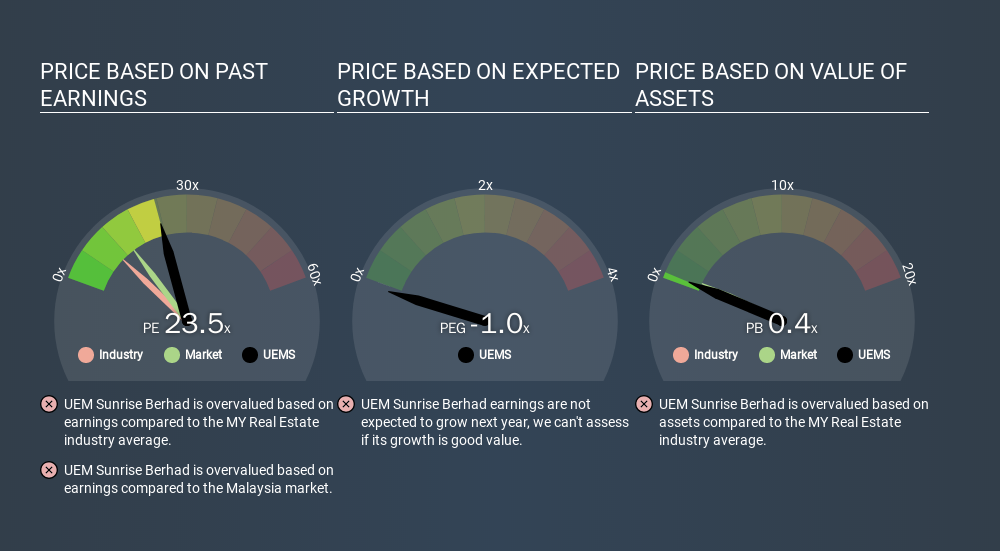
Today, we'll introduce the concept of the P/E ratio for those who are learning about investing. We'll look at UEM Sunrise Berhad's (KLSE:UEMS) P/E ratio and reflect on what it tells us about the company's share price. UEM Sunrise Berhad has a P/E ratio of 23.53, based on the last twelve months. That corresponds to an earnings yield of approximately 4.3%.
View our latest analysis for UEM Sunrise Berhad
How Do You Calculate A P/E Ratio?
The formula for price to earnings is:
Price to Earnings Ratio = Share Price ÷ Earnings per Share (EPS)
Or for UEM Sunrise Berhad:
P/E of 23.53 = MYR0.61 ÷ MYR0.03 (Based on the year to September 2019.)
Is A High P/E Ratio Good?
The higher the P/E ratio, the higher the price tag of a business, relative to its trailing earnings. That is not a good or a bad thing per se, but a high P/E does imply buyers are optimistic about the future.
Does UEM Sunrise Berhad Have A Relatively High Or Low P/E For Its Industry?
We can get an indication of market expectations by looking at the P/E ratio. The image below shows that UEM Sunrise Berhad has a higher P/E than the average (9.6) P/E for companies in the real estate industry.

That means that the market expects UEM Sunrise Berhad will outperform other companies in its industry. Shareholders are clearly optimistic, but the future is always uncertain. So investors should delve deeper. I like to check if company insiders have been buying or selling.
How Growth Rates Impact P/E Ratios
If earnings fall then in the future the 'E' will be lower. That means even if the current P/E is low, it will increase over time if the share price stays flat. A higher P/E should indicate the stock is expensive relative to others -- and that may encourage shareholders to sell.
UEM Sunrise Berhad's earnings per share fell by 42% in the last twelve months. And EPS is down 16% a year, over the last 5 years. This growth rate might warrant a below average P/E ratio.
A Limitation: P/E Ratios Ignore Debt and Cash In The Bank
One drawback of using a P/E ratio is that it considers market capitalization, but not the balance sheet. That means it doesn't take debt or cash into account. In theory, a company can lower its future P/E ratio by using cash or debt to invest in growth.
Such spending might be good or bad, overall, but the key point here is that you need to look at debt to understand the P/E ratio in context.
How Does UEM Sunrise Berhad's Debt Impact Its P/E Ratio?
Net debt totals a substantial 117% of UEM Sunrise Berhad's market cap. This level of debt justifies a relatively low P/E, so remain cognizant of the debt, if you're comparing it to other stocks.
The Bottom Line On UEM Sunrise Berhad's P/E Ratio
UEM Sunrise Berhad has a P/E of 23.5. That's higher than the average in its market, which is 14.2. With significant debt and no EPS growth last year, shareholders are betting on an improvement in earnings from the company.
Investors should be looking to buy stocks that the market is wrong about. If the reality for a company is better than it expects, you can make money by buying and holding for the long term. So this free visual report on analyst forecasts could hold the key to an excellent investment decision.
You might be able to find a better buy than UEM Sunrise Berhad. If you want a selection of possible winners, check out this free list of interesting companies that trade on a P/E below 20 (but have proven they can grow earnings).
If you spot an error that warrants correction, please contact the editor at editorial-team@simplywallst.com. This article by Simply Wall St is general in nature. It does not constitute a recommendation to buy or sell any stock, and does not take account of your objectives, or your financial situation. Simply Wall St has no position in the stocks mentioned.
We aim to bring you long-term focused research analysis driven by fundamental data. Note that our analysis may not factor in the latest price-sensitive company announcements or qualitative material. Thank you for reading.
About KLSE:UEMS
UEM Sunrise Berhad
An investment holding company, engages in the township and property development business in Malaysia, Australia, Singapore, and South Africa.
Moderate growth potential with acceptable track record.

